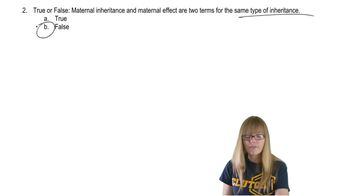Describe a tautomeric shift and how it may lead to a mutation.
Ch. 15 - Gene Mutation, DNA Repair, and Transposition

Chapter 15, Problem 12
Why are X rays more potent mutagens than UV radiation?
 Verified step by step guidance
Verified step by step guidance1
Understand the nature of X rays and UV radiation in terms of their energy and wavelength. X rays have shorter wavelengths and higher energy compared to UV radiation.
Recognize that the higher energy of X rays allows them to penetrate deeper into biological tissues and cause more direct damage to DNA molecules.
Learn that X rays can cause ionization, which means they can remove tightly bound electrons from atoms, leading to breaks in the DNA strands (both single and double-strand breaks).
Contrast this with UV radiation, which primarily causes damage by inducing the formation of thymine dimers—covalent linkages between adjacent thymine bases—leading to distortions in the DNA structure but generally not causing strand breaks.
Conclude that because X rays cause more severe types of DNA damage (strand breaks and ionization) compared to the more localized damage caused by UV radiation, they are considered more potent mutagens.

Verified video answer for a similar problem:
This video solution was recommended by our tutors as helpful for the problem above.
Video duration:
2mWas this helpful?
Key Concepts
Here are the essential concepts you must grasp in order to answer the question correctly.
Types of Radiation and Their Energy Levels
X-rays are a form of ionizing radiation with higher energy than ultraviolet (UV) radiation. This higher energy allows X-rays to penetrate cells and tissues more deeply, causing more severe damage to DNA molecules compared to UV radiation.
Recommended video:
Guided course

Types of Maternal Inheritance
Mechanisms of DNA Damage by Radiation
X-rays cause direct breaks in the DNA strands, including single- and double-strand breaks, which are difficult for the cell to repair. In contrast, UV radiation primarily induces thymine dimers, which distort the DNA but are generally easier for cellular repair mechanisms to fix.
Recommended video:
Guided course

DNA Proofreading
Mutagenic Potency and Cellular Repair
The mutagenic potency of radiation depends on the extent and type of DNA damage and the efficiency of cellular repair systems. Because X-rays cause more complex and severe DNA damage, they have a higher chance of causing mutations that persist, making them more potent mutagens than UV radiation.
Recommended video:
Guided course

Repair Pathways
Related Practice
Textbook Question
1306
views
Textbook Question
Contrast and compare the mutagenic effects of deaminating agents, alkylating agents, and base analogs.
1004
views
Textbook Question
Why are frameshift mutations likely to be more detrimental than point mutations, in which a single pyrimidine or purine has been substituted?
709
views
Textbook Question
DNA damage brought on by a variety of natural and artificial agents elicits a wide variety of cellular responses involving numerous signaling pathways. In addition to the activation of DNA repair mechanisms, there can be activation of pathways leading to apoptosis (programmed cell death) and cell-cycle arrest. Why would apoptosis and cell-cycle arrest often be part of a cellular response to DNA damage?
847
views
Textbook Question
Contrast the various types of DNA repair mechanisms known to counteract the effects of UV radiation. What is the role of visible light in repairing UV-induced mutations?
749
views
Textbook Question
Mammography is an accurate screening technique for the early detection of breast cancer in humans. Because this technique uses X rays diagnostically, it has been highly controversial. Can you explain why? What reasons justify the use of X rays for such a medical screening technique?
580
views
